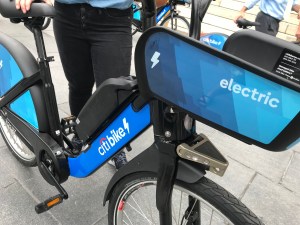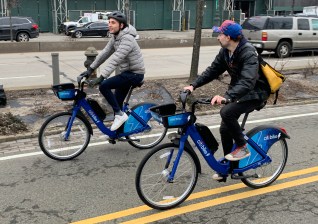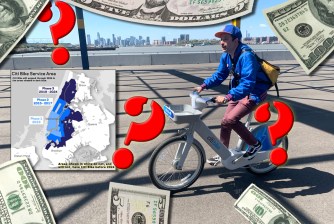From ‘Thousands,’ Citi Bike Now Promises ‘Hundreds’ Of New E-Bikes This Summer

Where’s the e-bike Lyftbowski?
Electrified pedal-assist Citi Bikes are still a rare sight in New York City, three months after the bike share company promised “thousands” of such bikes by the end of summer. Now a spokesperson said the Lyft-owned company hopes to get up to “hundreds” of e-bikes.
“We are on track to add hundreds more throughout the rest of the summer and more on top of that this year,” a Lyft spokesperson told Streetsblog, blaming coronavirus-related supply chain issues for the delays and shortages.
Citi Bike riders who want to get a boost because they’re going over a bridge or taking a long ride on the big blue bikes still have to contend with the minuscule initial rollout of about 250 pedal-assist bikes that Lyft added to the bike share system back in February, even as Citi Bike expands further into Manhattan and the Bronx.
“This is my first time riding one,” Citi Bike rider Carlos Ruiz told Streetsblog at the station on 95th Street and Third Avenue, venting after weeks of fruitless searching for a powered-up ride.
At its height, Citi Bike had 1,000 pedal-assist bikes in its fleet between 2018 and 2019, before the bikes were pulled because improperly installed brakes resulted in some rider injuries. The company then spent months promising that e-bikes would return in 2019, before finally unveiling its new e-bike in February, 2020. At that time, Lyft promised “hundreds” of pedal-assist bikes would be joining the system, after an initial rollout of 250 e-bikes. Then Lyft told Gothamist in May that it would add “thousands on the street by the end of the summer.”
Frustrated pedal-assist fans can attest to the lack of reliable e-bike rides both through the eye test (watching sadly as someone who gets to the only e-bike within a half-mile of you rides away as you walk to the dock) and through advanced statistics, which show that Citi Bike has barely added more e-bikes to the system. Recent tweets from @CitiBikeStats, a bot that scrapes the company’s open data to tweet information such as the number of open docks or rideable bikes in the system at any given time, has shown just under 200 and just over 300 available pedal-assist bikes to ride on an average weekday morning in August.
There are currently 14,370 docked bikes available to ride. 192 are electric. There are also 906 unavailable docked bikes.
— CitiBike Stats (@CitiBikeStats) August 10, 2020
There are currently 14,536 docked bikes available to ride. 315 are electric. There are also 838 unavailable docked bikes.
— CitiBike Stats (@CitiBikeStats) August 7, 2020
Tweets from late February show that riders could find slightly over 200 docked pedal-assist bikes when the bikes were re-introduced, indicating a lack of big changes over the last six months.
There are currently 12,436 docked bikes available to ride. 226 are electric. There are also 478 unavailable docked bikes.
— CitiBike Stats (@CitiBikeStats) February 21, 2020
Even as the e-bike program remains on power saver mode, people are still choosing to use bike share right now. According to Citi Bike’s June report to the Department of Transportation, there were 1,914,570 Citi Bike trips taken that month, for an average of 63,819. In June 2019, those numbers were at 2,164,915 total trips and 72,163 average trips per day, which means bike share is just 11 percent off the pace from last year — a year when millions more New Yorkers were commuting to work, recreating, or simply going out on the town.
Citi Bike also proved itself to be an essential commuting option during this year, and offered free annual memberships to healthcare workers during the coronavirus crisis in response to the increased usage of the docks outside city hospitals. The previously announced expansion into upper Manhattan and the Bronx has continued as well, despite the pandemic. (To find out when various neighborhoods will come on line, visit the DOT website here.)
But Citi Bike itself has pitched the pedal-assist bikes as a game changer for urban mobility, as its in-house data showed that people were using e-bikes to ride farther than they did with traditional Citi Bikes, choosing the e-bikes to get over East River bridges and even picking the bikes as their ride of choice in colder weather.

In a city where subway usage is still struggling to regain even 30 percent of its pre-pandemic ridership, Citi Bike’s rebound from an April nadir of 692,152 trips this year shows that the bike share service is very much part of the city’s bike boom, and could be an even bigger piece with the expanded range that pedal-assist provides.
“People are replacing transit trips, and maybe even Uber trips, with Citi Bike, and obviously we can do well with more pedal-assist bikes around here,” said Bike New York Communications Director Jon Orcutt.
The de Blasio administration does not put any public money into Citi Bike equipment or day-to-day operations, as it does for every other form of public transportation, including the highly subsidized ferry system, which is used by far fewer people per day than Citi Bike.




